Abstract
1. The febrile sensitivity of male Sprague-Dawley rats to microinjections of prostaglandin E1 (PGE) was investigated at three different locations in the rostromedial hypothalamic region. These were the preoptic anterior hypothalamic area (PO-AH), the organum vasculosum laminae terminalis (OVLT) and the rostral third ventricle (3V). 2. Stainless-steel cannula guide tubes were implanted in the OVLT region of one group of animals, within the PO-AH area of a second group and into the third ventricle of a third group of rats. After their recovery, the febrile response of each group was tested to a variety of doses of PGE, each administered in a volume of 1 microliter sterile 0.9% saline, via a sterile cannula inserted into the implanted guide tubes. Metabolic, vasomotor and rectal temperature changes were monitored continuously for the duration of the fevers. 3. Surprisingly, not only did the introduction of PGE into the OVLT region produce fevers, but the sensitivity of this region to PGE in the production of fever greatly exceeded that of the PO-AH area and the third ventricle. Fevers produced by microinjection of PGE into the PO-AH and 3V were identical. 4. Doses of PGE as low as 0.5 ng injected into the OVLT produced fevers of 0.5 degrees C. The fever dose threshold for the OVLT region was one-fifth those of the PO-AH area and the 3V, and the slope of the OVLT dose-response curve was twice those of the PO-AH and the 3V dose-response curves. 5. This study demonstrates that there is an anatomically distinct, regional sensitivity in the febrile responsiveness to PGE within the hypothalamus. These results are interpreted as evidence that the site of action of PGE in the production of fever is located within or immediately adjacent to the OVLT region, rather than within the medial PO-AH neuropil as has been believed previously.
Full text
PDF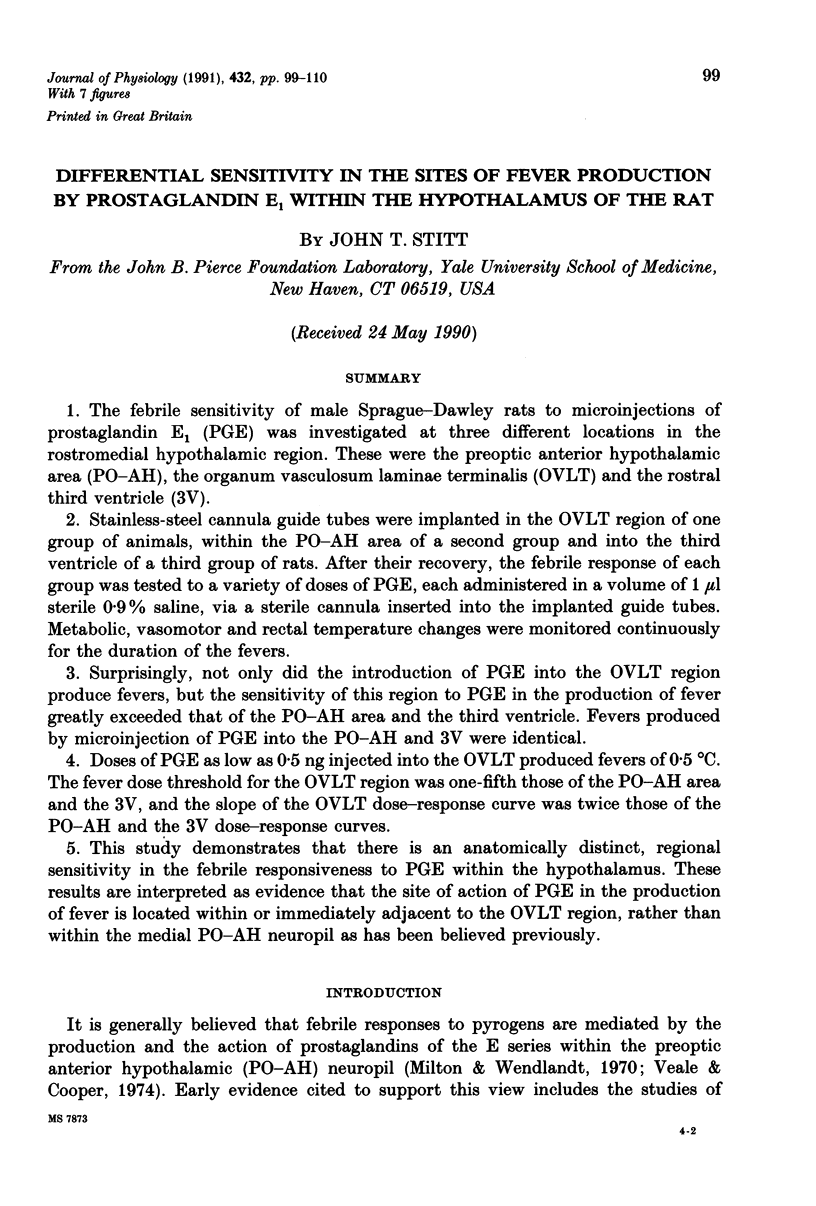
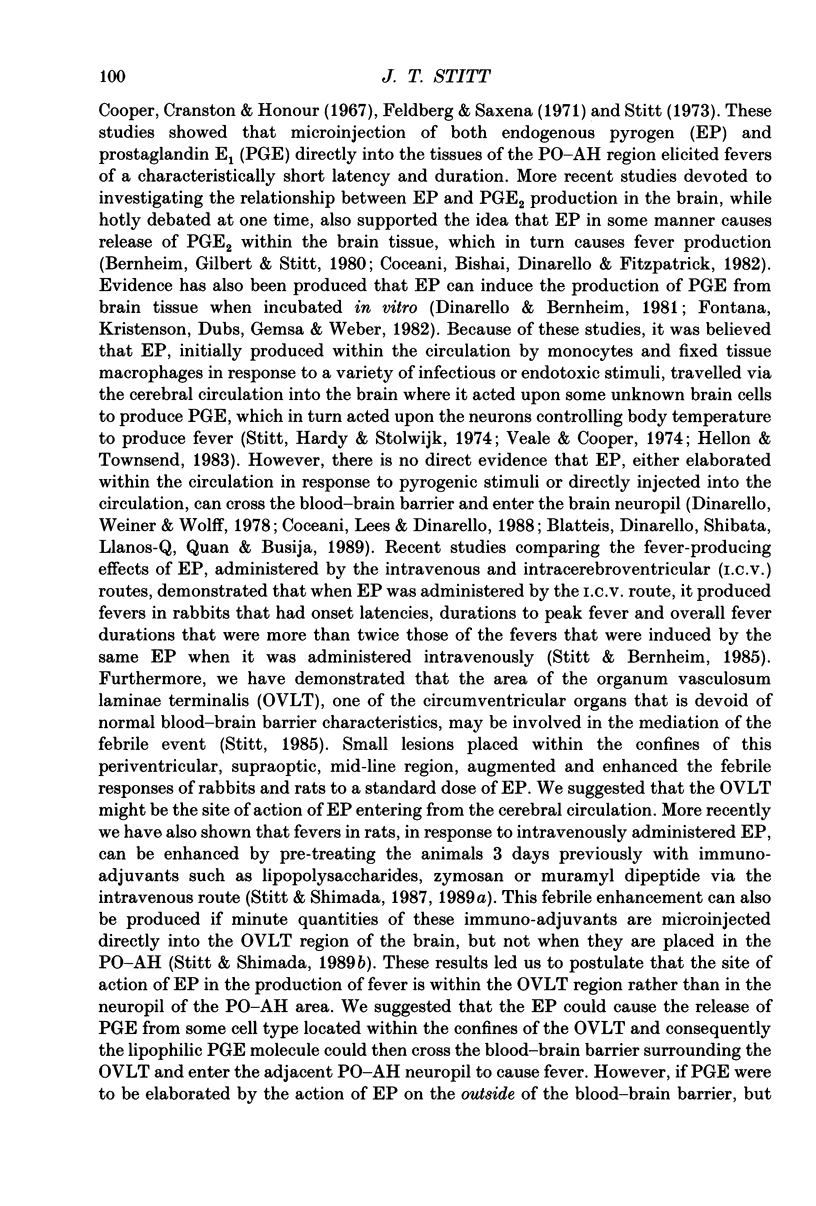
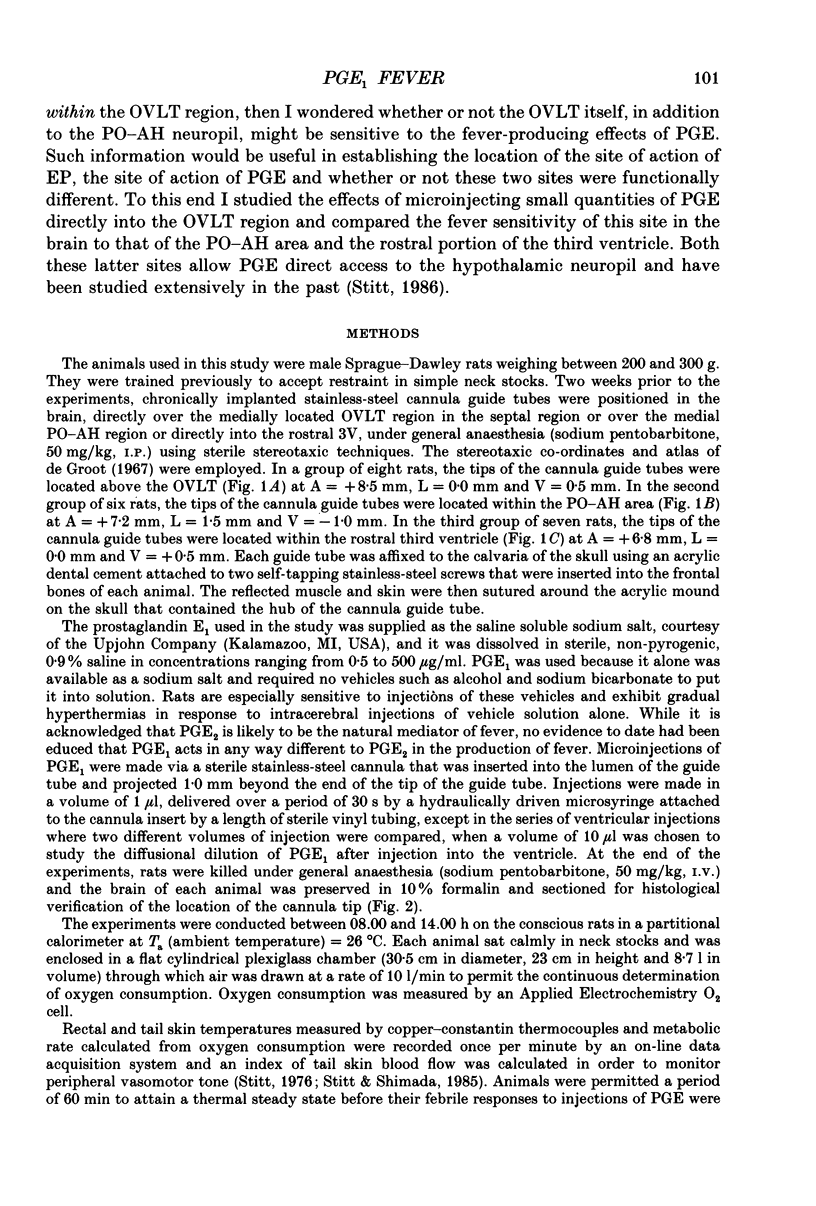
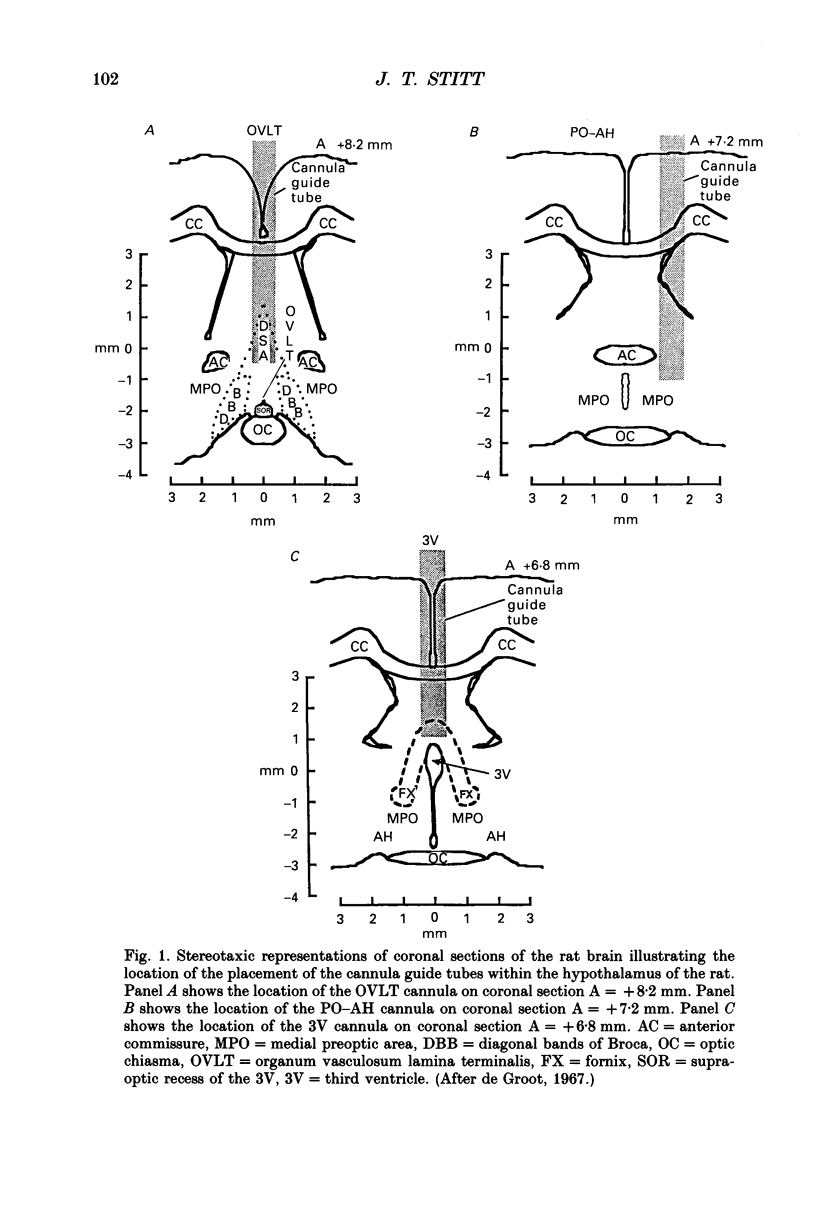
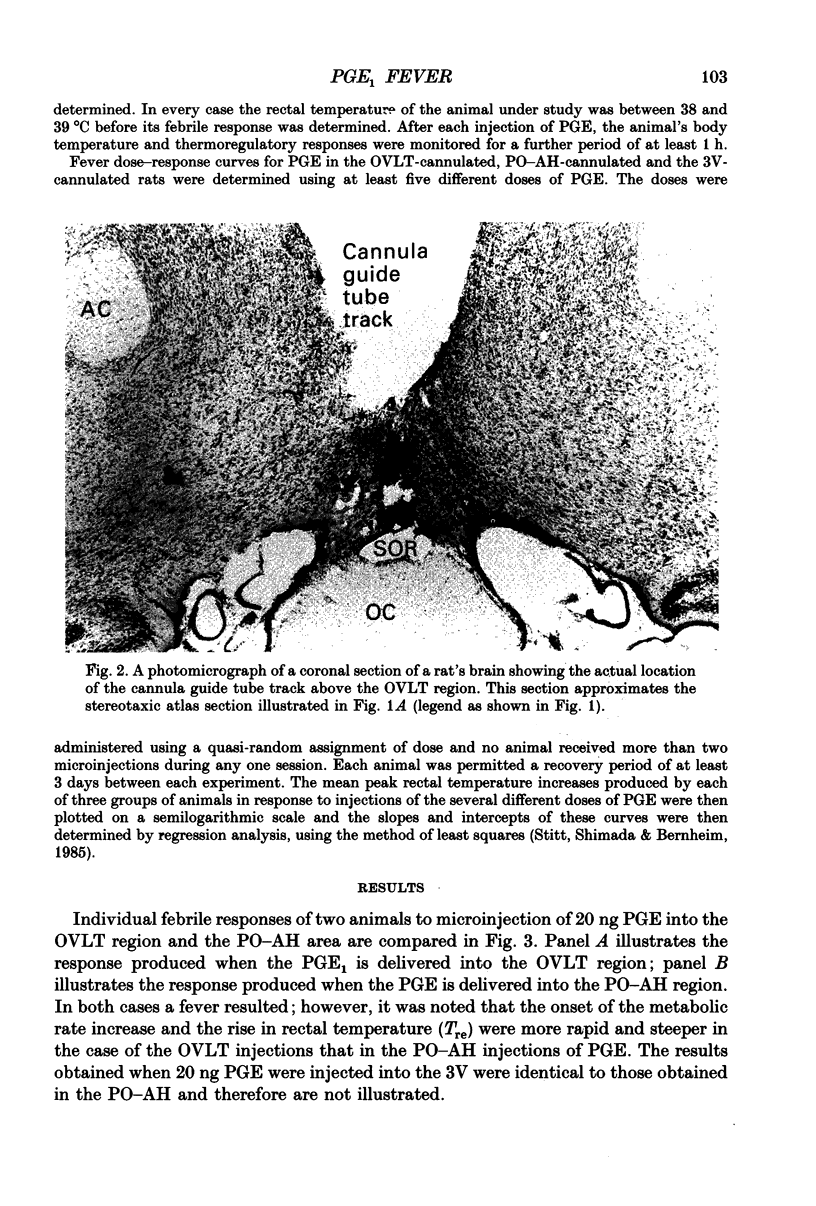
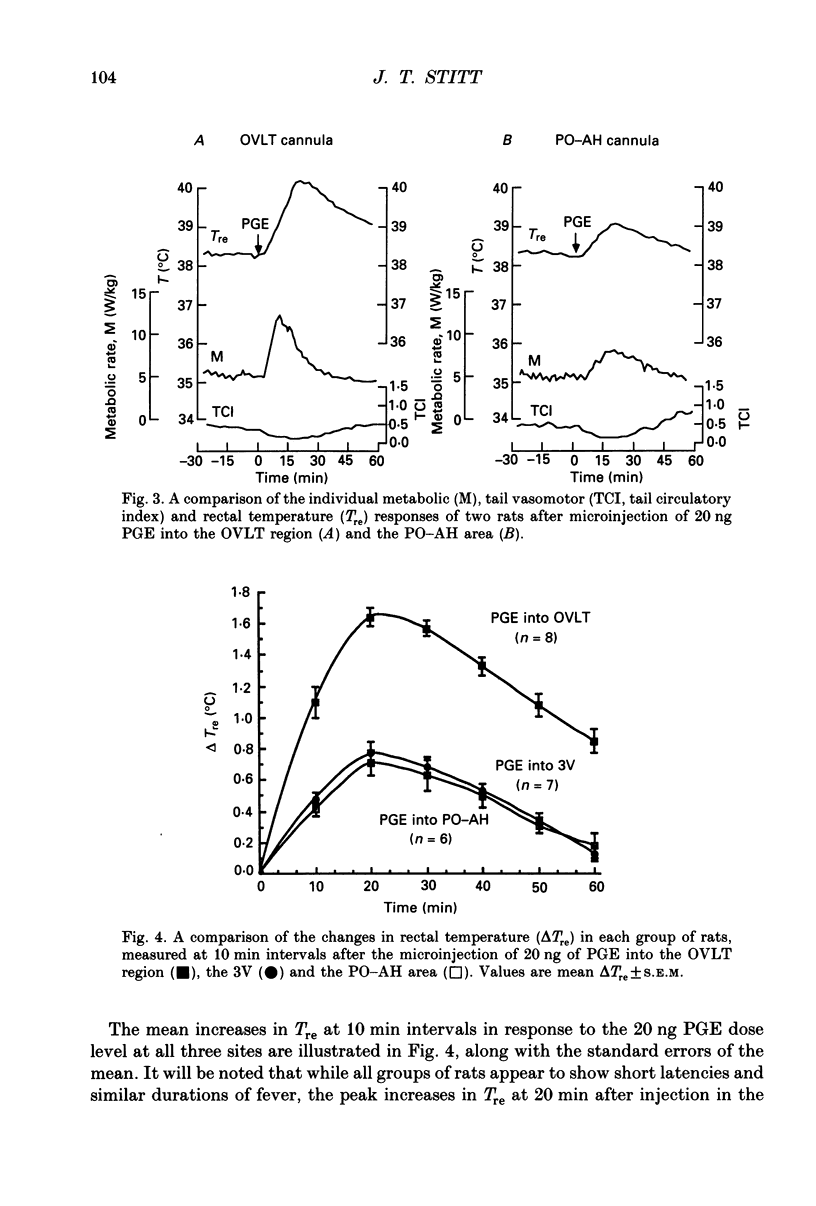
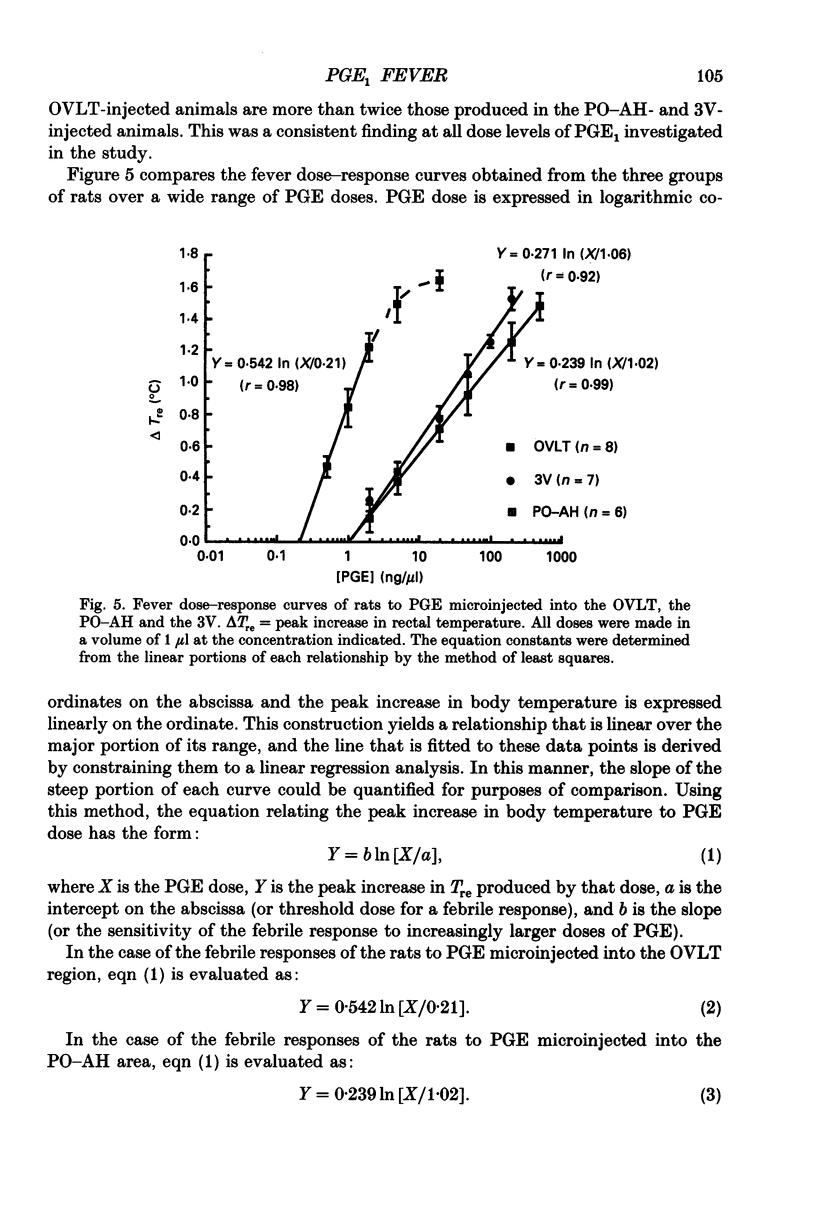
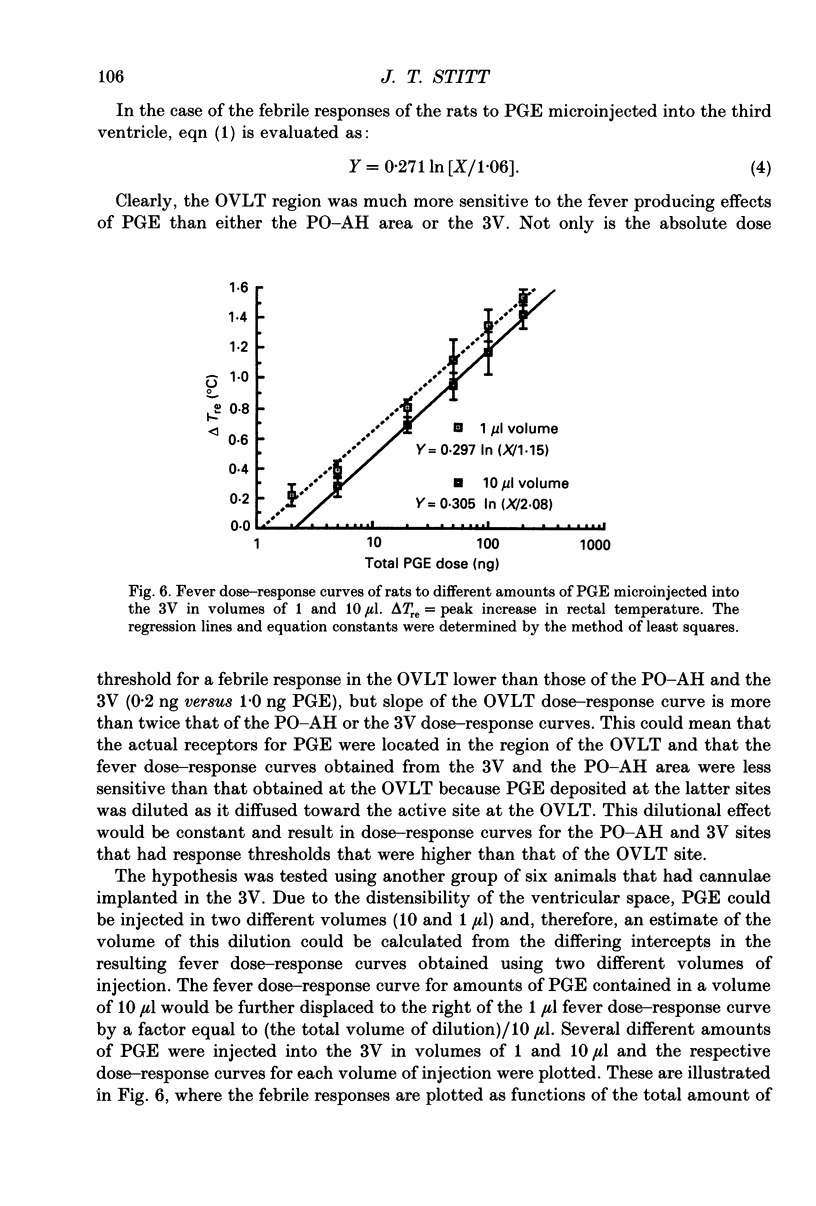
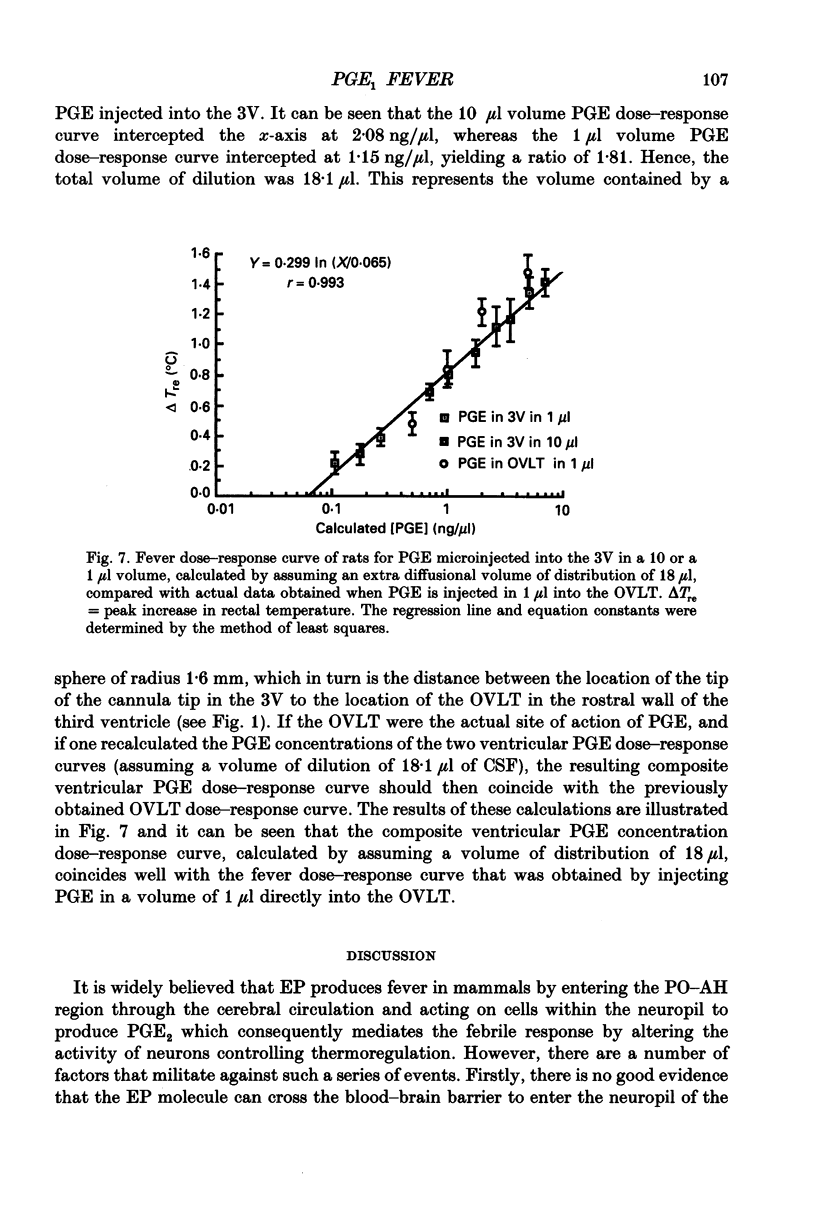
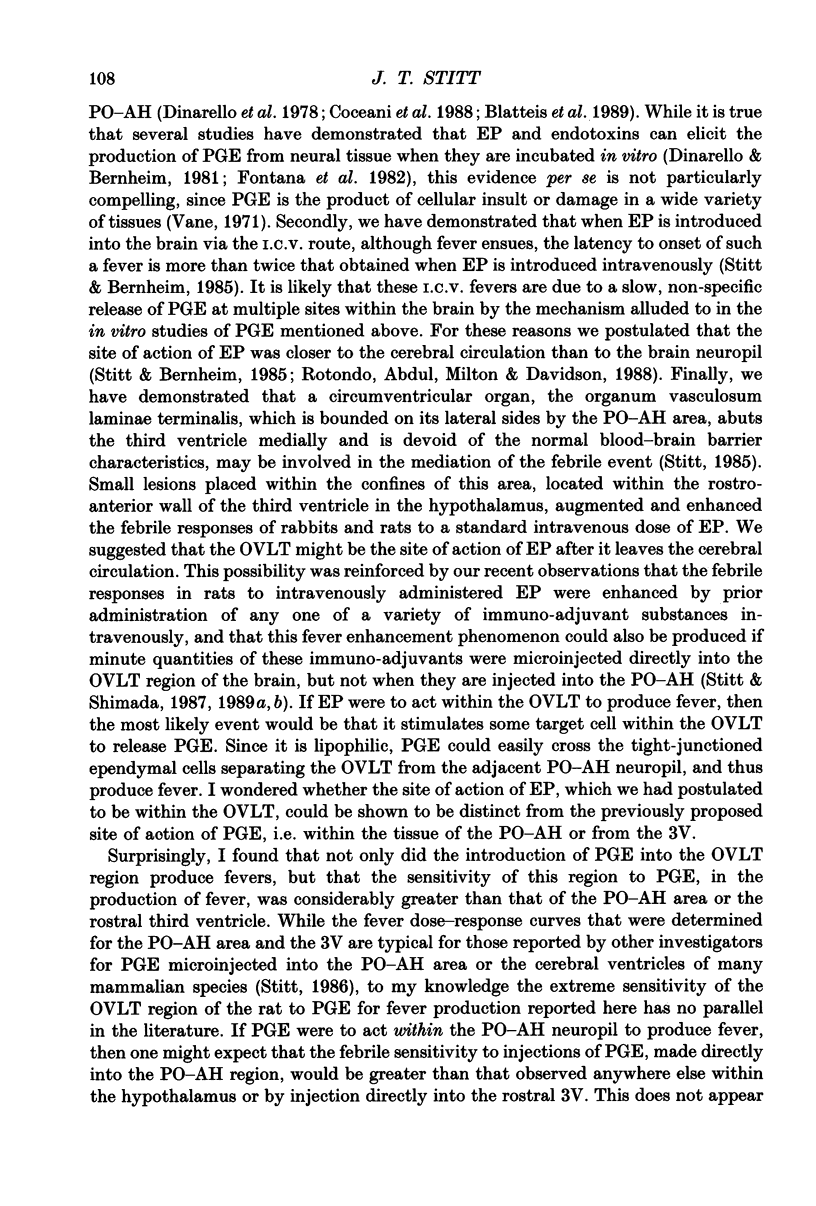
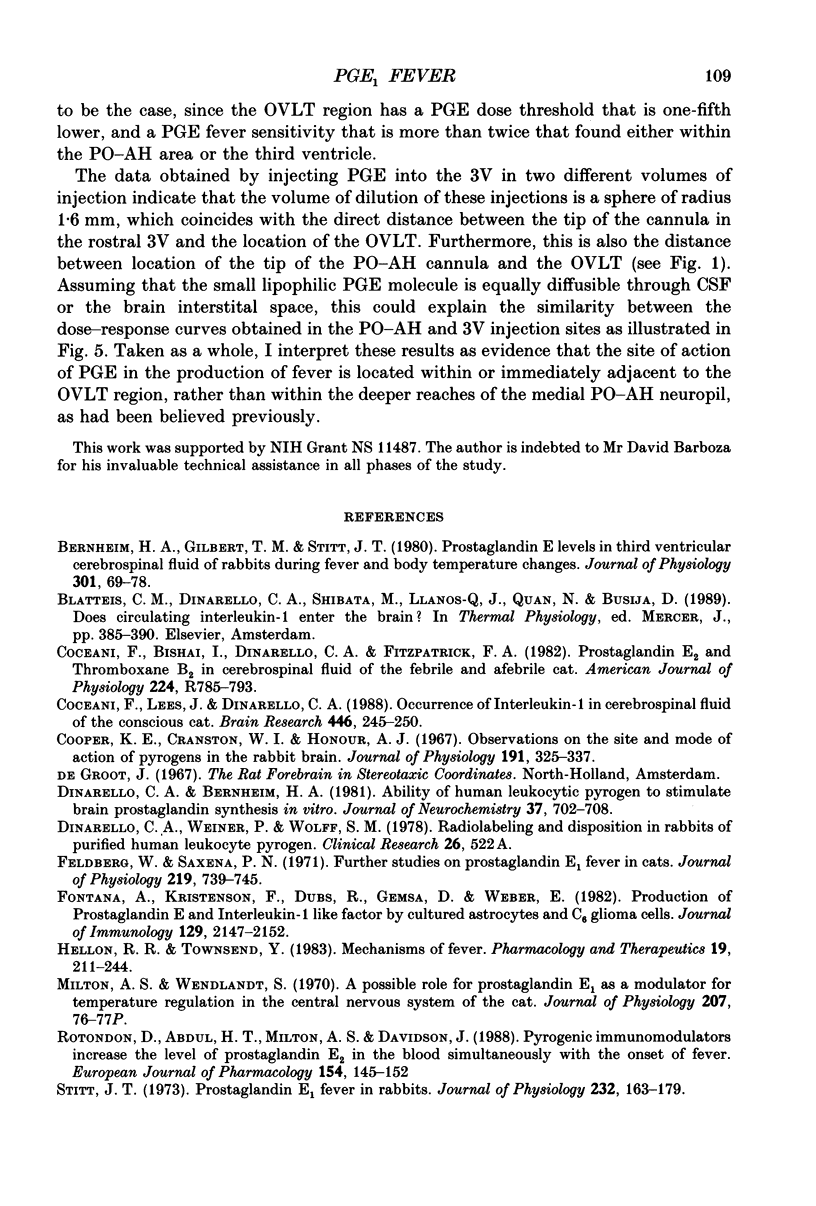
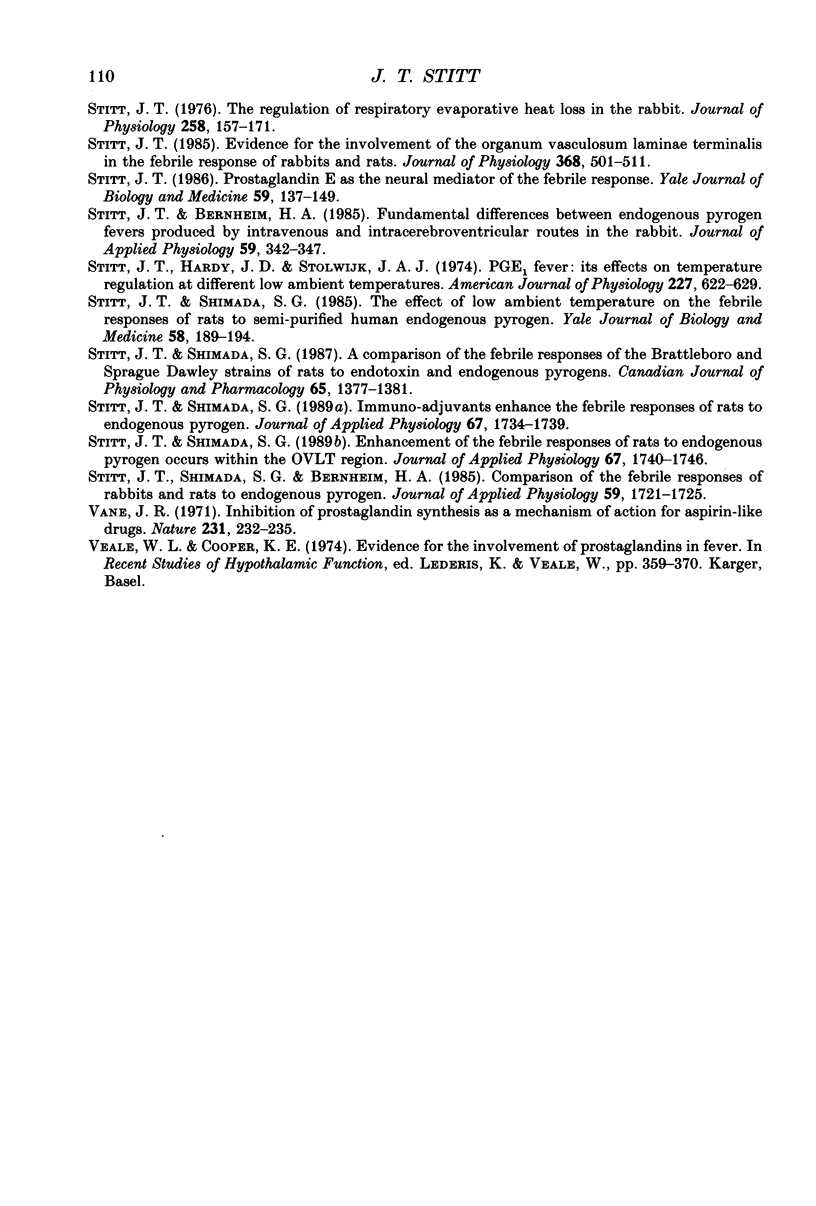
Images in this article
Selected References
These references are in PubMed. This may not be the complete list of references from this article.
- Bernheim H. A., Gilbert T. M., Stitt J. T. Prostaglandin E levels in third ventricular cerebrospinal fluid of rabbits during fever and changes in body temperature. J Physiol. 1980 Apr;301:69–78. doi: 10.1113/jphysiol.1980.sp013189. [DOI] [PMC free article] [PubMed] [Google Scholar]
- Coceani F., Lees J., Dinarello C. A. Occurrence of interleukin-1 in cerebrospinal fluid of the conscious cat. Brain Res. 1988 Apr 19;446(2):245–250. doi: 10.1016/0006-8993(88)90883-9. [DOI] [PubMed] [Google Scholar]
- Cooper K. E., Cranston W. I., Honour A. J. Observations on the site & mode of action of pyrogens in the rabbit brain. J Physiol. 1967 Jul;191(2):325–337. doi: 10.1113/jphysiol.1967.sp008253. [DOI] [PMC free article] [PubMed] [Google Scholar]
- Dinarello C. A., Bernheim H. A. Ability of human leukocytic pyrogen to stimulate brain prostaglandin synthesis in vitro. J Neurochem. 1981 Sep;37(3):702–708. doi: 10.1111/j.1471-4159.1982.tb12544.x. [DOI] [PubMed] [Google Scholar]
- Feldberg W., Saxena P. N. Further studies on prostaglandin E 1 fever in cats. J Physiol. 1971 Dec;219(3):739–745. doi: 10.1113/jphysiol.1971.sp009686. [DOI] [PMC free article] [PubMed] [Google Scholar]
- Hellon R., Townsend Y. Mechanisms of fever. Pharmacol Ther. 1982;19(2):211–244. doi: 10.1016/0163-7258(82)90063-8. [DOI] [PubMed] [Google Scholar]
- Milton A. S., Wendlandt S. A possible role for prostaglandin E1 as a modulator for temperature regulation in the central nervous system of the cat. J Physiol. 1970 Apr;207(2):76P–77P. [PubMed] [Google Scholar]
- Rotondo D., Abul H. T., Milton A. S., Davidson J. Pyrogenic immunomodulators increase the level of prostaglandin E2 in the blood simultaneously with the onset of fever. Eur J Pharmacol. 1988 Sep 13;154(2):145–152. doi: 10.1016/0014-2999(88)90091-x. [DOI] [PubMed] [Google Scholar]
- Stitt J. T., Bernheim H. A. Differences in endogenous pyrogen fevers induced by iv and icv routes in rabbits. J Appl Physiol (1985) 1985 Aug;59(2):342–347. doi: 10.1152/jappl.1985.59.2.342. [DOI] [PubMed] [Google Scholar]
- Stitt J. T. Evidence for the involvement of the organum vasculosum laminae terminalis in the febrile response of rabbits and rats. J Physiol. 1985 Nov;368:501–511. doi: 10.1113/jphysiol.1985.sp015872. [DOI] [PMC free article] [PubMed] [Google Scholar]
- Stitt J. T., Hardy J. D., Stolwijk J. A. PGE1 fever: its effect on thermoregulation at different low ambient temperatures. Am J Physiol. 1974 Sep;227(3):622–629. doi: 10.1152/ajplegacy.1974.227.3.622. [DOI] [PubMed] [Google Scholar]
- Stitt J. T. Prosaglandin E1 fever induced in rabbits. J Physiol. 1973 Jul;232(1):163–179. doi: 10.1113/jphysiol.1973.sp010262. [DOI] [PMC free article] [PubMed] [Google Scholar]
- Stitt J. T. Prostaglandin E as the neural mediator of the febrile response. Yale J Biol Med. 1986 Mar-Apr;59(2):137–149. [PMC free article] [PubMed] [Google Scholar]
- Stitt J. T., Shimada S. G. A comparison of the febrile responses of the Brattleboro and Sprague-Dawley strains of rats to endotoxin and endogenous pyrogens. Can J Physiol Pharmacol. 1987 Jun;65(6):1377–1381. doi: 10.1139/y87-216. [DOI] [PubMed] [Google Scholar]
- Stitt J. T., Shimada S. G., Bernheim H. A. Comparison of febrile responsiveness of rats and rabbits to endogenous pyrogen. J Appl Physiol (1985) 1985 Dec;59(6):1721–1725. doi: 10.1152/jappl.1985.59.6.1721. [DOI] [PubMed] [Google Scholar]
- Stitt J. T., Shimada S. G. Enhancement of the febrile responses of rats to endogenous pyrogen occurs within the OVLT region. J Appl Physiol (1985) 1989 Nov;67(5):1740–1746. doi: 10.1152/jappl.1989.67.5.1740. [DOI] [PubMed] [Google Scholar]
- Stitt J. T., Shimada S. G. Immunoadjuvants enhance the febrile responses of rats to endogenous pyrogen. J Appl Physiol (1985) 1989 Nov;67(5):1734–1739. doi: 10.1152/jappl.1989.67.5.1734. [DOI] [PubMed] [Google Scholar]
- Stitt J. T., Shimada S. G. The effect of low ambient temperature on the febrile responses of rats to semi-purified human endogenous pyrogen. Yale J Biol Med. 1985 Mar-Apr;58(2):189–194. [PMC free article] [PubMed] [Google Scholar]
- Stitt J. T. The regulation of respiratory evaporative heat loss in the rabbit. J Physiol. 1976 Jun;258(1):157–171. doi: 10.1113/jphysiol.1976.sp011412. [DOI] [PMC free article] [PubMed] [Google Scholar]
- Vane J. R. Inhibition of prostaglandin synthesis as a mechanism of action for aspirin-like drugs. Nat New Biol. 1971 Jun 23;231(25):232–235. doi: 10.1038/newbio231232a0. [DOI] [PubMed] [Google Scholar]



